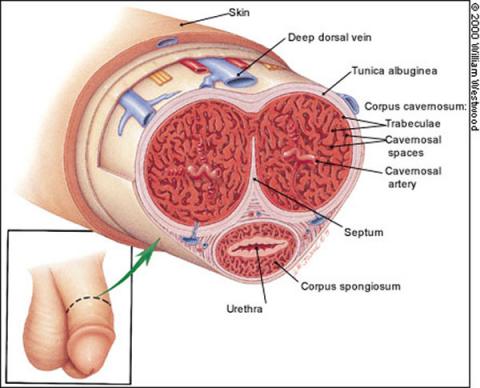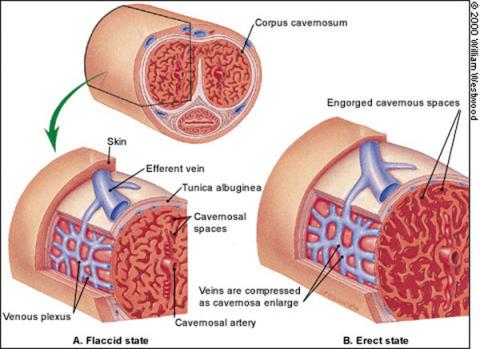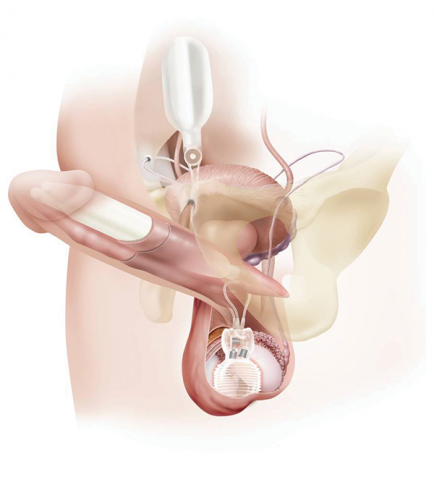Erectile dysfunction, often referred to as ED, is a term that covers a wide range of problems that men might experience in achieving a satisfactory erection to allow sexual intercourse to the level expected by the man and his partner. It can include the following:
-
Inability to achieve any erection whatsoever.
-
Inability to achieve an erection firm enough for sexual intercourse.
-
Inconsistent ability to achieve satisfactory erections.
-
Erections only satisfactorily rigid for a short time.
-
Premature ejaculation.
-
Delayed ejaculation.
Most men think of an unsatisfactory erection when they think of ED.
It is important to realise, that whilst ED is more common the older men get it is NOT an invariable consequence of aging. It is treatable irrespective of age, and in many cases it is curable. It is now accepted that a healthy sexual life and the ability to achieve normal erections is predictive of better overall male health and definitely beneficial to any man.
How do I get an erection?
The penis consists of three internal tubes – one for the passage of urine (the urethra) and two that consist of a spongy tissue (the corpora) that can become engorged with blood and hence result in an erection.


Small blood vessels in the pelvis open after appropriate stimulation resulting in an increased blood flow to the penis and corpora. As the spongy tissue inside the corpora fill with blood, they press up against the firm outer coating of the corpora and compress the outflow veins, resulting in an even firmer erection. When the erection goes down, it is usually when the pelvic blood vessels close, resulting in less blood flowing into the system, opening the outflow veins and the penis goes down and becomes flaccid once more.
What are the causes of erectile dysfunction?
Since an erection requires a precise sequence of events, ED can occur when any of the events is disrupted. As the pelvic blood vessels described above are about the same diameter as the blood vessels to the heart erectile dysfunction is regarded as a signal for potential heart disease. Screening for cardiovascular issues is usually advisable. There can also be issues with the nervous system – brain, spinal column and peripheral that may contribute to ED, as well as local tissue damage.
Causes of ED include the following:
Medication
-
Anti-hypertensives.
-
Anti-depressants.
-
Sedatives.
-
Hormonal medications.
-
Cardiac drugs in general.
Lifestyle Issues
-
Smoking.
-
Obesity.
-
Excess alcohol.
-
Sedentary lifestyle.
-
Fatigue.
Surgery
-
Radical prostatectomy.
-
Cystectomy (removal of bladder).
-
Lower bowel surgery.
-
Certain vascular procedures.
These procedures can cause damage to nerves, blood vessels, smooth muscles to the penis/corpora.
Diseases
-
Diabetes.
-
Multiple sclerosis.
-
Atherosclerosis.
-
Vascular disease.
-
Neurological disease.
All can result in erection issues. Diabetes in particular has a high association with erection problems - >50% will suffer some form of ED if they suffer from diabetes.
Psychological Factors
-
Stress.
-
Anxiety.
-
Depression.
-
Fear of failure.
-
Guilt.
All are thought to contribute to poorer quality erections.
How is ED diagnosed?
The diagnosis of erectile dysfunction (ED) involves the following steps:
History
A simple description of the problem – does the erection get sufficiently hard, does it last long enough, can you still ejaculate are some of the basic questions to be considered. Your other medical history is also important. Some men may like to complete the International Index of Erectile Function (IIEF) as an indicator of the severity of their problem. Download International Index of Erectile Function document.
Physical Examination
The doctor will usually perform an examination directed at the important areas that may indicate the source of the problem. The genital area and prostate are often examined as well as a broader physical on occasions.
Blood Tests
It is quite common for the following tests to be ordered:
-
Testosterone and other hormone tests.
-
General blood and chemistry assay.
-
Lipid studies – cholesterol etc.
-
Blood sugar level.
Other Tests
You may also be asked to undergo other tests such as:
-
Penile Doppler studies.
-
Peripheral Vascular assessment.
How is ED treated?
There are quite a few different therapies available for the treatment of ED. It is usual to start with the most conservative and non-invasive methods applicable to an individual’s actual condition. Some of the available treatments are listed below.
Lifestyle Changes
The same lifestyle measures as are regarded as being most beneficial to our heart, are equally applicable to a man’s erections. Addressing all issues of the metabolic syndrome (cholesterol, BP, blood sugar, weight) can all lead to an improvement in the quality of erections. Stopping smoking and regular exercise are also beneficial.
Medication Changes
A review of all medications can be beneficial. If a medication is contributing to ED then your GP may be able to suggest alternatives that do not have the same side effect. Anti-hypertensives and anti-anxiolytics are especially prone to cause ED.
Drugs
There are a number of different drugs that can be used to treat ED. They are not all suitable for all men. And their success varies from man to man.
Oral
The phospho-diesterase 5 inhibitors (PDE5Is) have revolutionised the treatment of ED. Viagra (Sildenafil) was the first to become available, but Levitra (Vardenafil) and Cialis (Tadenafil) are also available in Australia. All are “on-demand” drugs, that is, you take them when you need them, but Cialis also comes in a daily tablet form. This class of drugs is not suitable for men suffering from angina or, who are presently taking medication to stop angina.
Intracavernosal Injections
There are a number of drugs (and drug combinations) that can be injected directly into the penis to achieve an erection. Prostaglandin E1 is the base drug used, but Phentolamine, Papaverine and Atropine can all be used in combination. You will be taught the technique by your doctor. View Intracavernosal Injection Instructions.
Trans-cutaneous Applications
Glyceryl Trinitrate (the same drug rubbed on the chest to prevent angina) can also be rubbed onto the penis to help achieve an erection. Headache can be a possible side effect. A gel of PDE5Is is available in some countries.
Vacuum Devices
These are devices (also known as VEDs) that create a vacuum within a tube that draws blood into the penis, resulting in an erection. A specially designed band is usually placed around the base of the penis to trap blood within the penis and maintain the erection. These devices are not to everyone’s choice. They are also used on occasions to help maintain penile length in men after radical prostatectomy, or in men awaiting the insertion of a penile prosthesis.
Low Intensity Shock Wave Therapy
This is a relatively new therapy that delivers low-intensity shock waves to the penis. This causes new blood vessels to grow within the erectile tissue resulting in the improvement of erectile function. It is a painless outpatient therapy that is conducted over a period of weeks. Reports to date suggest that 70% of men will show some improvement at least.
Surgery

The most common type of surgery performed for the treatment of ED is the insertion of a penile prosthesis (implant).
Very rarely venous ligation is offered, though for the most part this type of surgery only offers temporary relief of the ED.
